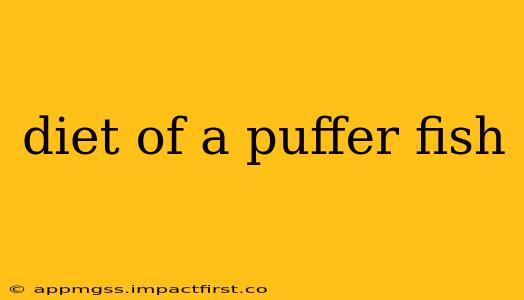Puffer fish, with their famously inflated bodies and sometimes toxic flesh, are fascinating creatures inhabiting diverse aquatic environments worldwide. But what do these quirky fish actually eat? Their diet is surprisingly varied and depends heavily on their specific species and habitat. Let's dive into the culinary habits of these intriguing animals.
What do different types of puffer fish eat?
This is a key question, as the diet of a puffer fish isn't uniform across all species. Smaller puffer fish often have a more limited diet compared to their larger counterparts. Generally, their diet can be categorized as omnivorous, meaning they consume both plants and animals.
Smaller species might primarily feed on invertebrates such as:
- Crustaceans: Shrimp, crabs, and other small crustaceans are common staples.
- Mollusks: Small snails and clams are also part of their menu.
- Worms: Various types of worms, both marine and freshwater, are consumed.
Larger species, however, often incorporate a wider variety of food sources, including:
- Fish: Smaller fish species are preyed upon by larger puffer fish.
- Sea urchins: These spiky creatures are a source of food for some puffer species.
- Algae and other plants: Certain puffer fish species include significant amounts of algae and other aquatic vegetation in their diets.
- Corals: Some species have been observed feeding on coral polyps.
What do puffer fish eat in the wild?
The wild diet of a puffer fish is dictated by its natural environment. A puffer fish residing in a coral reef will have a different diet than one found in a seagrass bed or a muddy estuary. In the wild, they are opportunistic feeders, taking advantage of readily available food sources. Their strong beaks help them crush the shells of mollusks and crustaceans, while their suction feeding mechanism allows them to effectively capture smaller prey.
What do pet puffer fish eat?
Keeping puffer fish as pets requires careful attention to their dietary needs. While the specific diet will depend on the species, a balanced diet typically includes:
- Commercial puffer fish food: These specially formulated pellets are designed to provide essential nutrients.
- Live food: Small crustaceans, such as brine shrimp and mysis shrimp, can be offered as supplementary food sources.
- Frozen food: Bloodworms and other frozen foods can also supplement their diet.
- Vegetables: Small pieces of blanched vegetables, like zucchini or spinach, can be offered sparingly to some species.
It's crucial to avoid feeding your pet puffer fish human food, as this can upset their digestive system and even be toxic. Always consult a veterinarian specializing in aquatic animals for advice on the best diet for your specific puffer fish species.
How often do puffer fish eat?
The feeding frequency for puffer fish varies depending on their size, age, and species. Younger, growing puffer fish require more frequent feedings, while adults may eat less frequently. Generally, providing food once or twice a day is sufficient. However, overfeeding should be avoided, as it can lead to obesity and other health problems. Observe your puffer fish carefully; if they are leaving food uneaten, you may be feeding them too much.
Are puffer fish dangerous to humans?
Some puffer fish species contain tetrodotoxin, a potent neurotoxin that can be fatal to humans if ingested. This toxin is not destroyed by cooking. Only specially trained chefs in certain regions of the world should prepare puffer fish for human consumption, and even then, there is a risk involved.
Therefore, while understanding their diet is fascinating, it's crucial to remember that caution should always be exercised when handling these intriguing but potentially dangerous creatures. Never attempt to eat a wild-caught puffer fish.
